CBC: Toronto calls in troops to fight snowstorm
Broadcast Date: Jan. 13, 1999
A series of record snowstorms plagues Toronto blanketing the region and disrupting the lifeline of Canada’s largest metropolis. With no end to the snowfall in sight, Mayor Mel Lastman requests military assistance to help the city shovel out from beneath the white mass. In response to Lastman’s plea, over 400 troops from CFB Petawawa, backed by armoured vehicles, descend upon the paralyzed city, helping bring it back onto its frozen feet.
Toronto calls in troops to fight snowstorm
• The city was hit with the first and worst storm of the year on Jan. 2 when a large portion of Southern Ontario — from Windsor to Kingston — received between 20 and 40 cm of snow. More than five million people were affected by the storm with an estimated 11 people losing their lives. Thousands of travellers spent one of the busiest travel days of the year stranded at Toronto’s Pearson International Airport.
• An additional four storms hit the city, with the snowfall finally tapering off after Jan. 15. Toronto usually receives 125 cm of snow every year. However, in January of 1999, the multiple snowstorms dumped a record snowfall of 118.4 cm in less than two weeks. And, at 65 cm, Toronto had seen the greatest snow on the ground at any one time. In fact, Toronto witnessed the snowiest two-week period since 1846.
• The largest city in Canada spends $32.2 million annually on snow removal. By the end of January 1999, though, the efforts to dig Toronto out of its snowy chaos had cost the city $70 million. During that period, Toronto also lost nearly $2 million in parking ticket revenue.
• Lastman’s request for military assistance was mocked by many across Canada as cowardly and excessive. On Friday, Jan. 15, the headlines of the Winnipeg Free Press, the newspaper of a city known for its harsh winters, read, “Honest, Toronto … we (Ha!) feel your pain.”
• Named Operation Preamble, the snowy campaign was fought by troops from Petawawa as well as from other regions of Ontario and Quebec and was headed by Lt.-Col. Julian Chapman, commanding officer of the Toronto Scottish Regiment. Some of the tasks the troops performed included transforming their 14-tonne Bisons (eight-wheeled armoured vehicles) into onsite emergency rooms and ambulances, transporting patients from accident scenes to hospitals and clearing inaccessible streets.
• Born in 1933, Mayor Mel Lastman, a former furniture and appliance salesman, was the mayor of the City of North York from 1972 until 1997 and then mayor of post-amalgamation Toronto until 2003.
• Mayor Lastman’s Jan. 13 request for help was actually the second time in two years that the military had been called in to help Canada’s urban regions deal with weather-related crises. In 1998, soldiers waged war against ice in Quebec and eastern Ontario during the ice storm. You can see and hear more about this event in the CBC Archives topic The Ice Storm of 1998.
• Aside from the military, approximately 80 residents of Prince Edward Island joined in the relief efforts, spending more than two weeks hauling away one million tonnes of snow from the downtown core. The smallest province in Canada would again display acts of national brotherhood four years later when it donated 9,000 kilograms of mussels, helping Toronto recuperate during the SARS crisis. These efforts were rewarded by Lastman’s declaration in 2003 that July 28 be Prince Edward Island Day.
Also on January 13:
1837: Fire destroys much of the Saint John, New Brunswick, business district.
1849: The Hudson’s Bay Company signs a lease with the British government acquiring control of Vancouver Island — for seven shillings a year.
1947: Britain’s Privy Council rules that Ottawa is within its rights to make the Supreme Court of Canada the country’s final court of appeal. Previously, Canadians had to take their cases to the Privy Council in London, England.
1982: Prime Minister Pierre Trudeau appoints Toronto social worker Ann Cools, Canada’s first black senator.
Toronto calls in troops to fight snowstorm
Medium: Television
Program: The National
Broadcast Date: Jan. 13, 1999
Host: Peter Mansbridge
Reporter: Adrienne Arsenault
Duration: 04:23
Last updated:
April 10, 2008
http://archives.cbc.ca/on_this_day/01/13/
CTV: Call in the army
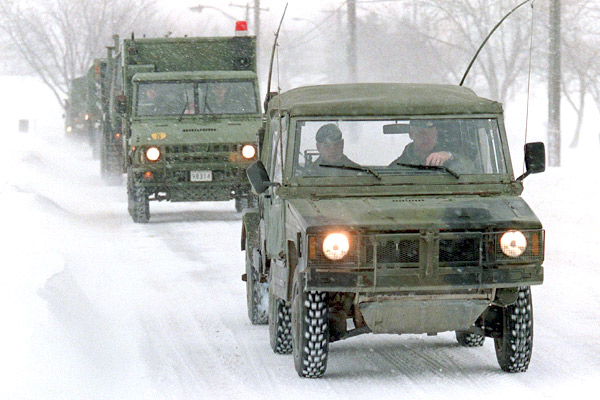
THE CANADIAN PRESS / Frank Gunn
Members of the Royal Canadian Dragoons arrive at Canadian Forces Base Downsview in Toronto on Thursday, Jan. 14, 1999. The Canadian Forces were called in to Toronto to assist with the snow and weather emergency.
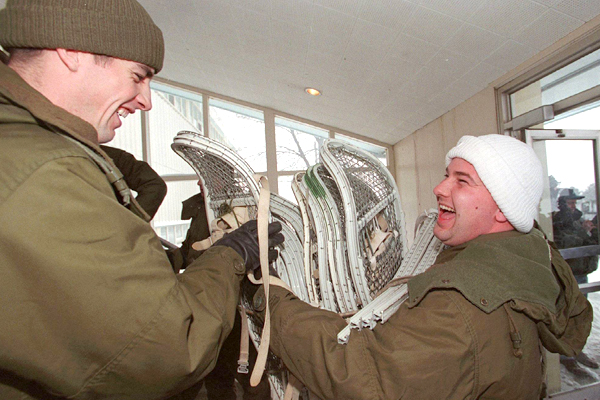
THE CANADIAN PRESS / Frank Gunn
Cpl. Brian Mundy and Trooper Steven Berezuk of the Royal Canadian Dragoons laugh as they unload snowshoes at Canadian Forces Base Downsview in Toronto, on Thursday, Jan. 14, 1999.
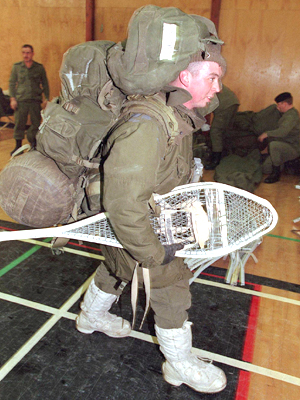
THE CANADIAN PRESS / Frank Gunn
Trooper Bernie Bertrand of the Royal Canadian Dragoons carries his snowshoes under his arm and his pack on his head as he arrives in the gym that will serve as a dormitory at Canadian Forces Base Downsview in Toronto on Thursday, Jan. 14, 1999.
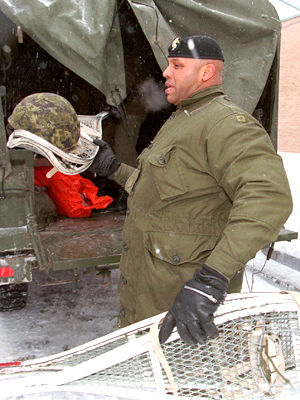
THE CANADIAN PRESS / Frank Gunn
Master Cpl. Douglas Courtney unloads snowshoes from his truck at Canadian Forces Base Downsview in Toronto, on Thursday, Jan. 14, 1999.
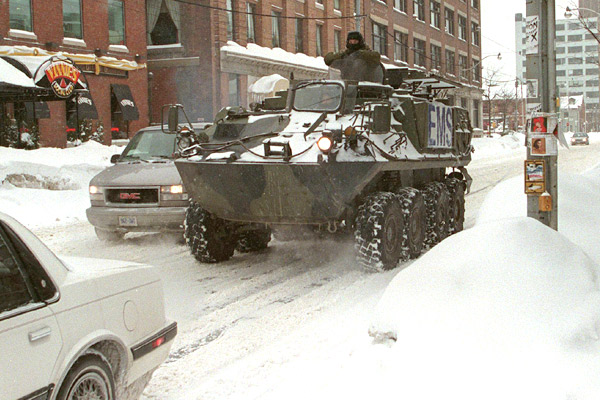
THE CANADIAN PRESS / Frank Gunn
A Canadian Forces Bison armoured personnel carrier drives into the Toronto downtown core Friday morning, Jan.15, 1999. The forces were called in to Toronto to assist with the snow and weather
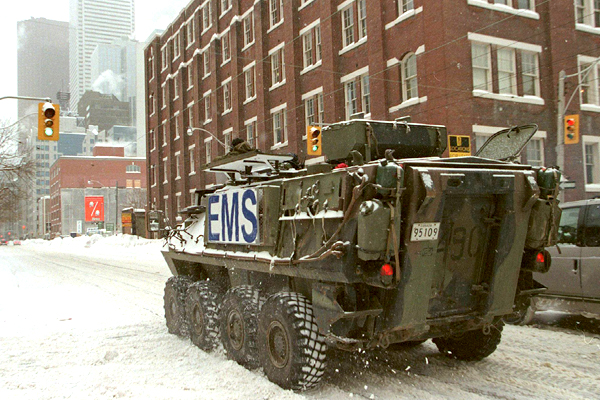
THE CANADIAN PRESS / Frank Gunn
A Canadian Forces Bison armoured personnel carrier drives into the Toronto downtown core on Friday morning, Jan. 15, 1999.
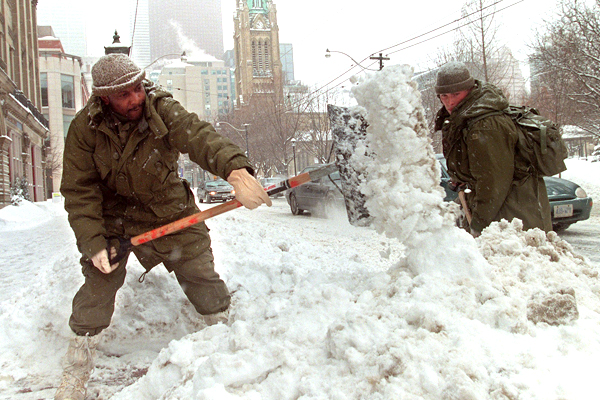
THE CANADIAN PRESS / Kevin Frayer
Master Cpl. Gary Walters and Pte. Paul Roventa of the Royal Canadian Regiment shovel snow in downtown Toronto on Friday, Jan. 15, 1999. The city was digging out from its third major snowstorm when the army was called in to help.
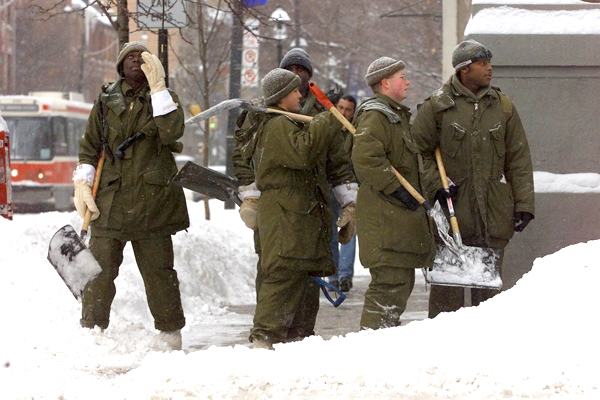
THE CANADIAN PRESS / Frank Gunn
Soldiers from the Royal Canadian Dragoons survey the task at hand as they hit the streets with shovels in downtown Toronto on Friday, Jan. 15, 1999.
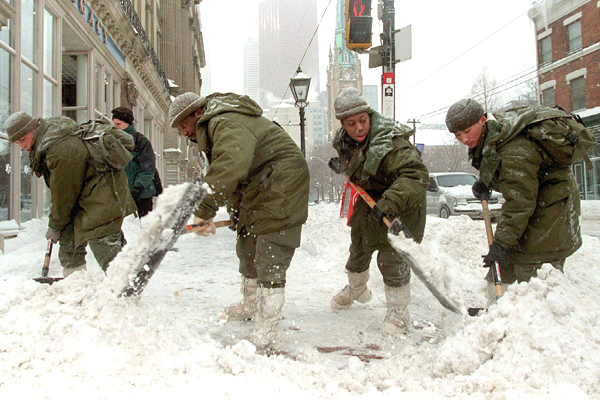
THE CANADIAN PRESS / Kevin Frayer
Members of the Royal Canadian Regiment — from left to right — Pte. Paul Roventa, Master Cpl. Gary Walters, Cpl. Cameron Kerryann and Pte. Phil Cheung shovel snow in Toronto, on Friday, Jan. 15, 1999.
http://toronto.ctv.ca/gallery/html/snow_army_20090106/photo_0.html
CTV: Mayor Mel has no regrets about army SOS
Bill Doskoch, ctvtoronto.ca
You might think of it as the original Snowmaggedon.
January 1999 was a brutal weather period for Toronto, with a 40-centimetre dump of snow starting things off on the second and third days of the year.
Ten days later, another snow system promised to bring another 15 to 25 centimetres of snow, with more to come. Winds gusting to 40 kilometres per hour made the -10C temperatures feel like -40C.
And so Mel Lastman, then the city’s mayor, made a decision on Jan. 13, 1999 that still causes smirks from Victoria to St. John’s — he called in the army.
“I remember as never seeing so much snow come down in my life at one time,” he told ctvtoronto.ca.
“I remember going out with my driver and taking a look at the old city of Toronto and driving south of Queen (Street) … and seeing narrow streets, and cars parked on both sides of the streets, and ruts in the centre — and wondering how the hell an ambulance would ever get down there.
“And I remember looking out my window at City Hall and not seeing any cars or anything driving along Queen Street.
“I said to myself, ‘Myself, what the hell am I going to do now?'” he said.
“I called the head of the army and said ‘what have you got … because this city could be in a lot of trouble’,” Lastman said.
According to a 2004 Esprit de Corps magazine article, Lastman placed a telephone call to then-defence minister Art Eggleton, a former Toronto mayor. The military dispatched a reconnaissance team.
By midnight on Jan. 13, Lastman said the military called him to say it would be putting some forces in place at the old Downsview base:
-more than 400 soldiers
-four Bison armoured personnel carriers
-and more than 30 pieces of snow removal equipment.
The soldiers and equipment left CFB Petawawa at 5 a.m. on Jan. 14, 1999 and arrived in Toronto to undertake Operation Preamble. Another 300 reservists in Toronto were called into action.
The Bisons were literally lifesavers, Lastman said. He credits them with saving at least 35 people over the emergency period. The Esprit de Corps article said the Bison ambulances carried out 20 missions over three days.
However, news reports at the time indicate there wasn’t much for the soldiers to do initially because no emergency declaration was in place.
By Jan. 15, a snow emergency was declared — the same day the snow started to taper off. The emergency order would stand for three days.
Most of the troops broke camp on Jan. 17 and returned to Petawawa. About 120 remained behind to help with snow removal.
The ‘right thing’
The reaction in other parts of Canada was mainly glee at the “centre of the universe’s” comeuppance — especially the army thing.
“Yeah, I took a lot of ribbing over it, but I did the right thing,” Lastman said. “I did something politicians are afraid to do — be safe rather than sorry, and act before somebody dies.”
Lastman said he saw the ribbing as good-natured but felt people didn’t really understand what was happening in the city.
Over 15 days, almost an entire season’s worth of snow had fallen — up to 118 centimetres. A typical January in Toronto at that time would see about 35 cm for the month, with 124 cm for an entire winter.
It would be described as the snowiest two-week period for the city since 1871.
There were more than 5,000 kilometres of roads to clear. GO Transit trains were shut down for two days, and the TTC was barely functioning, with fistfights breaking out between passengers frustrated by delays.
In fairness to Lastman, New York Gov. George Pataki declared an emergency for several counties in upper New York state. He authorized 83 troops from the National Guard to help with snow removal in Buffalo. Detroit and Chicago were also left reeling by the massive winter weather system.
While people remember the army, don’t forget the volunteers from Prince Edward Island who brought out snow removal equipment to help remove the massive piles of snow from roadways.
Other crews from London, Bracebridge, Montreal and Ottawa also helped out.
The snow emergency was declared over at 3 p.m. on Jan. 18, 1999, although the cleanup would continue until month’s end.
The P.E.I. volunteers were here to the end. As a treat, Lastman prevailed upon then-Toronto Maple Leafs chair Steve Stavro to find 100 tickets for them to the Jan. 30 game against the Washington Capitals.
“Those guys loved the game,” he said. During an intermission, the announcer told the crowd the P.E.I. volunteers were at the game, “and they’ve got biggest cheer I’ve heard anywhere,” he said.
Lastman said the whole episode showed him that as a mayor, don’t be afraid to overreact to a budding crisis — “even if you make a fool of yourself.
“And by not explaining it, they (the media) made a fool out of me! But I’m not unhappy about it, and I’ve never been unhappy about it,” he said. “Because I did the right thing, and if I do the right thing, I don’t care.
“Would I do it again? You’re darned right I would.”
http://toronto.ctv.ca/servlet/an/local/CTVNews/20090111/army_1999_091011/20090111?hub=Toronto



